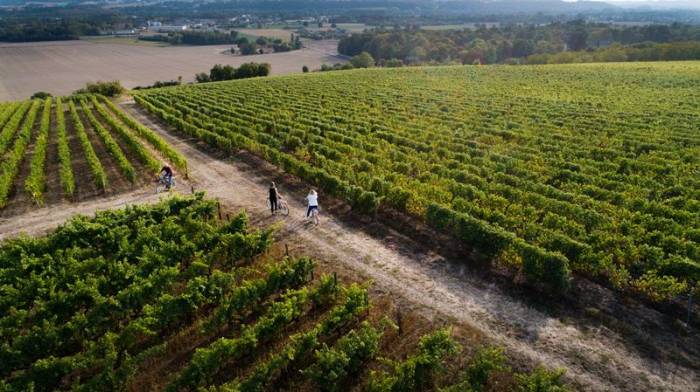Jasnières and Fiefs Vendéens See 627 Hectares of Vineyards Draw New Wave of Wine Tourists
Loire Valley’s hidden wine regions offer authentic tastings, cycling routes, and sustainable tourism away from crowded destinations
2025-11-07

In the heart of France’s Loire Valley, two lesser-known wine regions are quietly gaining attention among wine enthusiasts and travelers seeking authentic experiences. Jasnières and Fiefs Vendéens, both located away from the main tourist routes, offer a unique perspective on French winemaking and rural life. These regions are now drawing visitors who want to explore beyond the well-known names like Sancerre or Vouvray.
Jasnières is situated in the Sarthe department, north of the Loire River. It is the smallest appellation in the entire Loire Valley, with just 127 hectares of vineyards spread across the villages of Lhomme and Ruillé-sur-Loir. The area is dedicated exclusively to white wines made from Chenin Blanc, a grape variety celebrated for its ability to reflect the nuances of its terroir. Jasnières received its Appellation d’Origine Contrôlée (AOC) status in 1937, but its reputation dates back centuries. Historical records show that even during the reign of Henry IV, Jasnières wines were highly prized at court.
Today, Jasnières wines are known for their freshness, minerality, and aging potential. They are typically dry whites with firm structure and vibrant acidity, making them a good match for local goat cheeses, poultry, and charcuterie. The vineyards benefit from south-facing slopes and soils composed of clay and silica over limestone tuffeau, which help produce balanced and expressive wines.
Visiting Jasnières is more than just a tasting experience. The landscape features gentle hills along the Loir River valley, creating a picturesque setting for cycling or walking tours. Many producers, such as Domaine Lelais, welcome guests into cellars carved directly into the soft tuffeau stone. These underground spaces provide natural coolness and an atmospheric backdrop for sampling wines at their source. The hospitality of local winemakers adds to the sense of immersion in this quiet corner of the Loire.
For those interested in active tourism, Jasnières offers a 16-kilometer cycling route that winds through vineyards, small villages, and artisan workshops. This path allows visitors to experience the region’s pace of life while discovering its cultural heritage and natural beauty. The route is ideal for travelers looking to avoid crowded destinations and enjoy a more personal connection with the land.
Further southwest, near the Atlantic coast in Vendée, lies another emerging wine region: Fiefs Vendéens. Although it was officially recognized as an AOC only in 2011, winemaking here has deep roots dating back to the era of Cardinal Richelieu in the 17th century. The region covers about 500 hectares divided among five subzones: Brem, Chantonnay, Mareuil, Vix, and Pissotte. Each area has distinct characteristics shaped by soil composition and proximity to the ocean.
Fiefs Vendéens produces a range of wines—fresh whites, lively rosés, and structured reds—using at least six different grape varieties. The region’s history includes recovery from phylloxera in the late 19th century. Local growers revived their vineyards under the name “Anciens Fiefs du Cardinal” in 1951 before eventually achieving AOC status. Today’s wines are gaining recognition for their authenticity and artisanal quality.
The Atlantic climate imparts a unique freshness and subtle salinity to Fiefs Vendéens wines. These qualities make them well-suited to pair with regional cuisine such as Vendée ham with white beans (mogettes), fresh sardines from Saint-Gilles paired with Brem whites, or chilled Vix rosés enjoyed on summer afternoons by the coast. The Vendée Wine Route offers guided tours, tastings, and food events organized by local producers.
One notable estate in this region is Vignobles Mourat. This winery combines traditional methods with sustainable tourism practices. Visitors can choose between bike tours or electric vehicle excursions led by local guides who introduce them to historic castles, Romanesque churches, and scenic river landscapes. The experience often includes a picnic lunch featuring local products followed by cellar visits and guided tastings.
Both Jasnières and Fiefs Vendéens offer an alternative approach to French wine tourism—one that emphasizes authenticity, tradition, and sustainability. These regions remain largely undiscovered by mass tourism but provide rich opportunities for travelers interested in wine culture and rural heritage. As interest grows in lesser-known destinations that prioritize responsible tourism and genuine encounters with local producers, Jasnières and Fiefs Vendéens stand out as places worth visiting before they become widely recognized on the international stage.
Founded in 2007, Vinetur® is a registered trademark of VGSC S.L. with a long history in the wine industry.
VGSC, S.L. with VAT number B70255591 is a spanish company legally registered in the Commercial Register of the city of Santiago de Compostela, with registration number: Bulletin 181, Reference 356049 in Volume 13, Page 107, Section 6, Sheet 45028, Entry 2.
Email: [email protected]
Headquarters and offices located in Vilagarcia de Arousa, Spain.